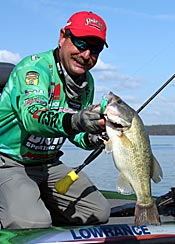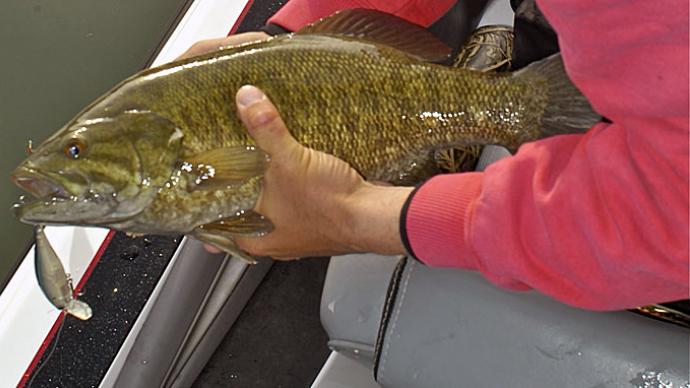
If you fish for bass and know who Kevin VanDam is, you have likely heard of Strike King Lure Company. Their lures have won tournaments for forty years in every level of competition. Denny Brauer, Shaw Grigsby, and George Cochran made Strike King Lures known through performances, seminars, and TV. However, people do not know that it’s not just the pros who design and develop product ideas; there is a team behind every lure that comes out on the market.
The Challenge
“Lures are harder to design. Colors are not as important for triggering strikes,” said Strike King Lure designer Phil Marks. “Today’s colors are mostly just variations of existing schemes. Colors have to be eye appealing. Many great fish-catching colors don't sell well because they are just plain ugly to the angler's eye.”
Like every product that hits store shelves, lures require testing, tweaking, experimenting, and designing. “It’s not cut and dry. Some require days and even months, while some are very quickly tested and approved,” explained Marks. “We routinely test baits via our pro-staff in different parts of the country, and some baits have national appeal, while some are regional.”
If you have ideas like moveable arms or other crazy lures, it may not be feasible. Lures not only get approval from pro-staffers but must also be feasible to make and sell. “Feasibility is a large part of our development process. It is also why during idea generation, we get constant input from our manufacturing, marketing, and salespeople,” said Marks., “I don't know an exact percentage, but I would guess probably half the ideas generated are not feasible.”
The Listening Portion
“We have a New Products committee, which is used for new idea generation,” explained Marks. “Part of the committee is our pro-staff. As a group, we generate about 98% of our ideas. Occasionally a consumer or a competitive product will generate something we will run with. We work on them 365 days a year.”
Marks noted committee has been in action for about fifteen years but formally for about ten years. He explained it is just a way for the company to ensure that all of the little pieces are addressed appropriately during the idea and prototyping stages.
“I oversee the committee composed of all of our Pros, sales representatives, marketing people, accounting, and manufacturing folks,” Marks added. “As a business, we have to have credible input from all the various parts of our company to be profitable and to give the angler the right tools for the trade.”
Color development is something Strike King is always playing with, Marks added. He has found that anglers generally want new colors and different styles and has found tweaks of colors tend to produce better on highly pressured fisheries. As a result, most of Strike King’s color additions come from the New Products Committee.
How does Strike King judge how good a prototype is? “Ultimately, the fisherman let us know through purchases which is good and which is average,” Marks commented. “What ultimately sets them apart is how well they catch fish day in and day out. So I use a set of criteria on the front end of a project.”
“If a lure meets 100% of the criteria, then those lures are usually very successful,” Marks explained. “Most of the lures do not hit every criterion; some are still huge hits, and some are mediocre. It is always a plus when the lure performs well for our pro staff, but some lures we market are not hardline tournament lures and are designed for the occasional angler. These types of lures are a little more difficult to gauge.”
How It All Starts
Lure designing is a chain reaction; it starts with an idea and progresses to a final product. The “reaction” starts with a pro-staffer, employee, or customer. Next, it goes through the evaluation process and, if approved, moves to rigorous prototyping with involvement from the design team and pro staffers.
“It varies, but the designer starts with more on the front end of a project, but more emphasis is placed on the pro-staff for the final tweaking. Sometimes good prototypes do not move forward due to industry trends, and sometimes they are fast-tracked for various reasons. In some cases, prototypes have been shelved, then those files will be re-opened several years later, and the bait launched, such as with the recent 10XD.”
Marks noted most of the Kevin VanDam Squarebills and the XD series of crankbaits have been hard to design because Kevin is particular about what he wants to achieve in each design. Marks has found spinnerbaits as a category are easy because Strike King has a long history in spinnerbait design and getting them to run correctly.
How does Strike King design some aspects of lures, such as how long it is, how much it weighs, or how it should look in the water?
“These variables are normally a result of what we want the lure to do and how it should perform. Not something that is decided on the front end. For example, if you want a lure to dive deep, then you know you have to cast it far; hence it cannot be a light lure, so these attributes are result oriented rather than decided on the front end,” said Marks.
How many versions will a new prototype or lure concept go through before it’s ready to go on the tournament trail or the market? “Hopefully, the fewer, the better; it makes my life much easier! But, all kidding aside, you never really know,” said Marks. “We want our baits to achieve a specific task. When we have that task in mind, we keep working until we get the bait exactly as we want it, sometimes, it is a single prototype, and sometimes it is a dozen. Typically, it's three to five tries before we narrow it down and get it right.”
Research Galore
Since companies follow trends with new products, you end up with several of the same-looking products, but they all have their features. “Due to the cyclical nature of our industry, trends tend to repeat themselves,” noted Marks. “If you are in the industry for a long time, you will see this. Hence when something old becomes "hot" again, there tends to be more research on pre-existing research to create a better mouse trap.”
How long does it take from idea to product?? “There is a lot of time variance here, but the minimum is six months and could be as long as three years in extreme cases. Hard baits are always harder and typically have less tolerance for error,” said Marks.
How complex is the process of naming a lure? So how do Marks and the Pro staff team come up with names such as Space Monkey, Smokin Rooster, or the Menace?
“That’s a hard question because naming baits is very difficult. Typically you want a name that is easy to remember and can tie in with the actions of the bait. Our New Products Committee is always working on names for lures. The lure is often finished before we decide on a name. Regarding the names mentioned above, some of our younger guys got silly and started naming those Rage Tail baits, and it worked, so we ran with that line of thought.”




